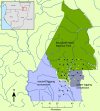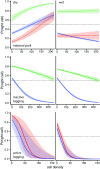Early detection of human impacts using acoustic monitoring: An example with forest elephants
- PMID: 39058671
- PMCID: PMC11280225
- DOI: 10.1371/journal.pone.0306932
Early detection of human impacts using acoustic monitoring: An example with forest elephants
Abstract
The impacts of human activities and climate change on animal populations often take considerable time before they are reflected in typical measures of population health such as population size, demography, and landscape use. Earlier detection of such impacts could enhance the effectiveness of conservation strategies, particularly for species with slow population growth. Passive acoustic monitoring is increasingly used to estimate occupancy and population size, but this tool can also monitor subtle shifts in behavior that might be early indicators of changing impacts. Here we use data from an acoustic grid, monitoring 1250 km2 of forest in northern Republic of Congo, to study how forest elephants (Loxodonta cyclotis) assess risk associated with human impacts across a landscape that includes a national park as well as active and inactive logging concessions. By quantifying emerging patterns of behavior at the population level, arising from individual-based decisions, we gain an understanding of how elephants perceive their landscape along an axis of human disturbance. Forest elephants in relatively undisturbed forests are active nearly equally day and night. However, they become more nocturnal when exposed to a perceived risk such as poaching. We assessed elephant perception of risk by monitoring changes in the likelihood of nocturnal vocal activity relative to differing levels of human activity. We show that logging is perceived to be a risk on moderate time and small spatial scales, but with little effect on elephant density. However, risk avoidance persisted in areas with relatively easy access to poachers and in more open habitats where poaching has historically been concentrated. Increased nocturnal activity is a common response in many animals to human intrusion on the landscape. Provided a species is acoustically active, passive acoustic monitoring can measure changes in human impact at early stages of such change, informing management priorities.
Copyright: © 2024 Wrege et al. This is an open access article distributed under the terms of the Creative Commons Attribution License, which permits unrestricted use, distribution, and reproduction in any medium, provided the original author and source are credited.
Conflict of interest statement
The authors have declared that no competing interests exist.
Figures










References
-
- Bartkowski B. Are diverse ecosystems more valuable? Economic value of biodiversity as result of uncertainty and spatial interactions in ecosystem service provision. Ecosyst Serv. 2017;24:50–7.
-
- Harrison PA, Berry PM, Simpson G, Haslett JR, Blicharska M, Bucur M, et al.. Linkages between biodiversity attributes and ecosystem services: A systematic review. Ecosyst Serv. 2014;9:191–203.
-
- Goldenberg SZ, Douglas-Hamilton I, Daballen D, Wittemyer G. Challenges of using behavior to monitor anthropogenic impacts on wildlife: a case study on illegal killing of African elephants. Animal Conservation. 2017;20(3):215–24.
MeSH terms
LinkOut - more resources
Full Text Sources

